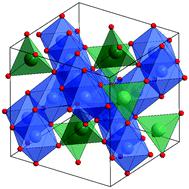当前位置:
X-MOL 学术
›
Inorg. Chem. Front.
›
论文详情
Our official English website, www.x-mol.net, welcomes your
feedback! (Note: you will need to create a separate account there.)
Low-temperature wet chemistry synthetic approaches towards ferrites
Inorganic Chemistry Frontiers ( IF 6.1 ) Pub Date : 2020-05-12 , DOI: 10.1039/d0qi00294a Stefano Diodati 1, 2, 3 , Richard I. Walton 4, 5, 6, 7 , Simone Mascotto 8, 9, 10, 11 , Silvia Gross 1, 2, 3
Inorganic Chemistry Frontiers ( IF 6.1 ) Pub Date : 2020-05-12 , DOI: 10.1039/d0qi00294a Stefano Diodati 1, 2, 3 , Richard I. Walton 4, 5, 6, 7 , Simone Mascotto 8, 9, 10, 11 , Silvia Gross 1, 2, 3
Affiliation

|
Ferrites are a broad class of iron-containing oxides that includes spinel ferrites MFe2O4, perovskites MFeO3, and hexagonal ferrites (hexaferrites) such as BaFe12O19. These materials have a wide array of applications owing to their diverse properties: notable instances include catalysis, piezoelectric components, magnetic components, biomedical applications, heterogeneous catalysis and photocatalysis. Given the growing importance of environmentally friendly, low-temperature methodologies to obtain functional materials, there is a growing interest in synthetic approaches which are compatible with the principles of “green chemistry”. In this context, wet chemistry represents an attractive choice, and furthermore offers the possibility of scale-up for manufacture of materials in volumes for practical application. Though there is a sizeable amount of literature on the synthesis of ferrites, the most common approaches require treatments at temperatures above 200 °C, either as the main synthetic procedure itself (thermal decomposition), or as a post-synthetic step (for example, calcination after sol–gel autocombustion). This review aims at summarising, categorising, classifying and critically discussing the different low-temperature (<200 °C), wet chemistry approaches employed in recent years for the synthesis of ferrites. This will include hydrothermal, solvothermal, sonochemical, and microwave methods, with examples taken from literature making reference to the various sub-classes of ferrites.
中文翻译:

低温湿化学合成铁氧体的方法
铁氧体是一类广泛的含铁氧化物,包括尖晶石铁氧体MFe 2 O 4,钙钛矿MFeO 3以及六方铁氧体(六价铁氧体),例如BaFe 12 O 19。这些材料由于其各种特性而具有广泛的应用:值得注意的实例包括催化,压电组件,磁性组件,生物医学应用,多相催化和光催化。鉴于环保,低温方法学对于获得功能材料的重要性日益提高,人们对与“绿色化学”原理兼容的合成方法的兴趣日益浓厚。在这种情况下,湿化学法是一个有吸引力的选择,此外,还提供了规模化生产用于实际应用的材料的可能性。尽管有关铁氧体合成的文献很多,但最常见的方法需要在200°C以上的温度下进行处理,既可以作为主要的合成程序本身(热分解),也可以作为合成后的步骤(例如,溶胶-凝胶自燃后的煅烧)。本文旨在总结,分类,分类和批判性地讨论近年来用于合成铁氧体的不同低温(<200°C)湿化学方法。这将包括水热法,溶剂热法,声化学法和微波法,并参考文献中涉及铁氧体各个子类别的例子。
更新日期:2020-05-12
中文翻译:

低温湿化学合成铁氧体的方法
铁氧体是一类广泛的含铁氧化物,包括尖晶石铁氧体MFe 2 O 4,钙钛矿MFeO 3以及六方铁氧体(六价铁氧体),例如BaFe 12 O 19。这些材料由于其各种特性而具有广泛的应用:值得注意的实例包括催化,压电组件,磁性组件,生物医学应用,多相催化和光催化。鉴于环保,低温方法学对于获得功能材料的重要性日益提高,人们对与“绿色化学”原理兼容的合成方法的兴趣日益浓厚。在这种情况下,湿化学法是一个有吸引力的选择,此外,还提供了规模化生产用于实际应用的材料的可能性。尽管有关铁氧体合成的文献很多,但最常见的方法需要在200°C以上的温度下进行处理,既可以作为主要的合成程序本身(热分解),也可以作为合成后的步骤(例如,溶胶-凝胶自燃后的煅烧)。本文旨在总结,分类,分类和批判性地讨论近年来用于合成铁氧体的不同低温(<200°C)湿化学方法。这将包括水热法,溶剂热法,声化学法和微波法,并参考文献中涉及铁氧体各个子类别的例子。











































 京公网安备 11010802027423号
京公网安备 11010802027423号